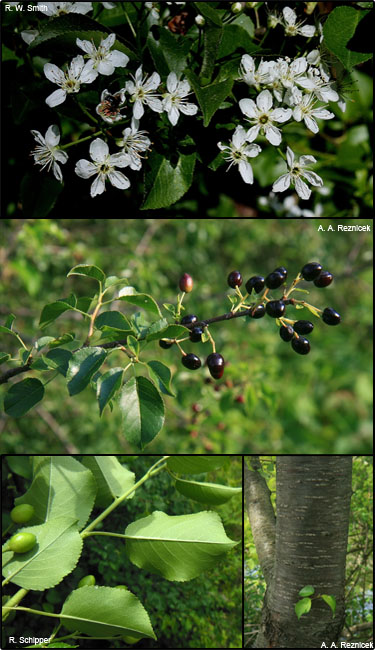Perfumed cherry (Prunus mahaleb)
 Common Names: Mahaleb cherry, St. Lucie cherry
Common Names: Mahaleb cherry, St. Lucie cherryDescription: Plant produces a toxin called hydrogen cyanide, which is mainly found in the leaves and seed. Grown mainly for its fragrant flowers and wood.
Habit: Deciduous tree or large shrub growing up to 29 feet in height and 29 feet across.
Leaves: Simple, alternate and toothed. Green in color and small (2.5-5 cm long) and nearly as wide as long, at least some of them appearing nearly round.
Stems: Grey-brown in color with conspicuous lenticels on young stems, and shallowly fissured on old trunks. Stems lack thorns.
Flowers: Fragrant, pure white, small (8-20 mm in diameter), with an 8-15 mm pedicel. Flowers appear in an inflorescence that typically has fewer than 10 flowers in a raceme.
Fruit and seeds: Small thin-fleshed cherry-like drupe 8-10 mm in diameter, green at first turning red then dark purple to black when mature, with a very bitter flavor; flowering occurs mid spring with the fruit ripening in mid to late summer.
Habitat: Native to the Mediterranean, Iran and parts of Central Asia. Found in moist forests, river banks, roadsides, fields, thickets, dump sites and railroads.
Reproduction: By seed
Similar species: The combination of its light green, broadly ovate to rotund and lustrious leaves, along with the extremely fragrant flowers and small black fruits help distinguish it from native Prunus species (Prunus spp.).
Credits: The information provided in this factsheet was gathered from the University of Michigan Herbarium - Michigan Flora, Plants For A Future, Henderson State University and Wikipedia.
Individual species images that appear with a number in a black box are courtesy of the Bugwood.org network (http://www.invasive.org).Individual photo author credits may not be included due to the small display size of the images and subsequent difficulty of reading the provided text. All other images appear courtesy of Google (http://images.google.com).
